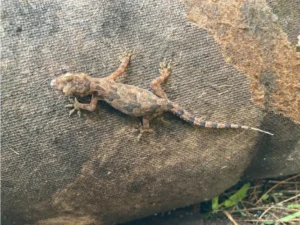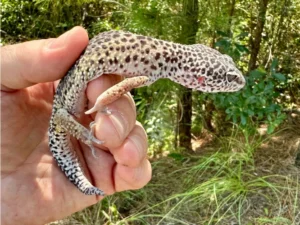If you’ve ever seen a lizard freeze when you walk by, then dart away as soon as you move again, you’ve probably wondered what it’s thinking.
Are they scared of people? Or are they just cautious by nature? They always look jumpy, like they’re expecting trouble. So are lizards actually afraid of humans?
Yes, most lizards are naturally afraid of humans, but not because they know what we are. They see us as large, unpredictable creatures that could be a threat, so their first instinct is usually to hide or run away. Some may eventually get used to people, but fear is their default reaction in the wild.
It’s not personal. Lizards aren’t afraid of you specifically. They’re just built to avoid danger.
That cautious behavior is what has kept them alive for millions of years.
Lizards Are Born to Be Careful
Think about how small most lizards are. Their fear makes a lot of sense. Almost anything bigger could hurt them. Birds, snakes, cats, dogs, and even other lizards sometimes go after them.

When a lizard sees a human, it doesn’t think, “That’s a person.” It just notices movement and size. Its survival instincts kick in, and that’s when you see it bolt under a rock or up a wall.
Being afraid isn’t a weakness. It’s smart. Lizards that waited too long didn’t survive to have babies.
Today’s lizards are the careful descendants of the ones who always stayed alert and ran first.
Why Lizards Run From You
Most lizards follow a few simple steps that help them stay safe:
-
Freeze: At first, they stop completely, hoping you won’t see them. Their colors often help them blend in.
-
Watch: They follow your movements carefully. If you get too close, they’ll dart for cover.
-
Hide: Once they’re in a safe spot (behind a plant, under a rock, or up high) they’ll stay there until they feel safe.
This isn’t thinking like a human. It’s more like a built-in reflex. Quick escapes can mean the difference between life and death, so it happens automatically.
Some Lizards Lose Their Fear Over Time
Not all lizards stay scared forever. If they live around humans for a while, some start to relax a little.
House geckos, for example, are common in warm places all over the world. They often live in or around people’s homes, hunting insects near lights.

Over time, they’ve learned that humans aren’t usually dangerous. You can often walk right by them without making them run.
Other species, like anoles or skinks, might get used to quiet spaces or slow movements. They’ll still keep their distance, but they won’t panic as easily.
That doesn’t mean they’re tame. It just means they’ve learned what’s safe and what’s not.
Lizards That Are Less Afraid of People
Some species are naturally bolder than others. Desert iguanas and some monitor lizards, for example, can be surprisingly calm around humans.
In places where people leave them alone, they might even let you come close.
Large monitor lizards in Sri Lanka or Indonesia often wander near villages, completely ignoring people while they dig for food or sunbathe.
The same goes for green iguanas in tropical cities. They’ll sit on fences, roofs, or sidewalks like they own the place. That confidence usually comes from living where people don’t bother them.
Lizards in the wild that are hunted or chased will stay skittish for life.
Fear Looks Different in Different Lizards
When a lizard’s scared, it doesn’t always just run. Each species has its own ways to stay safe.
Some, like anoles, drop from trees and change color to blend in. Skinks dive into leaf litter or burrow into sand. Geckos flatten against walls or ceilings and hide in plain sight.

Others take things further. Frill-necked lizards open their bright neck frill and hiss to look bigger. Horned lizards puff up, and in rare cases, even squirt blood from their eyes to scare predators.
So while most lizards fear humans, their reactions depend on the kind of defense they have.
Do Lizards Ever Attack People?
Almost never. Lizards don’t see humans as food, and they don’t get anything from attacking.
Their claws and teeth are mostly for catching insects or defending themselves from animals closer to their size.
If a lizard bites, it’s usually because it feels trapped or cornered. Even then, the bite from most small lizards doesn’t hurt much. It’s more of a warning than real harm.
Larger species, like monitor lizards or iguanas, can give stronger bites or tail whips, but that’s still self-defense, not aggression. Once they get a chance, they’ll run away fast.
Even though lizards look nervous, they’re not dangerous. They’d rather escape than fight.
Pet Lizards See Things Differently
If you’ve ever had a pet lizard, you might notice it acts differently than wild ones. That’s because it’s learned to see you as part of its environment, or at least as a source of food.

When you feed it, clean its tank, or handle it gently, the lizard slowly starts to feel comfortable around you. Some may even come forward when you open the tank because they know it’s mealtime.
Still, even tame lizards can get startled by quick movements or loud noises. That instinct never fully goes away.
If you want your pet lizard to feel safe, move slowly, stay calm, and handle it carefully.
Why Lizards Need to Stay Alert
In the wild, being afraid keeps lizards alive. Their fear helps them avoid:
-
Predators: Birds, snakes, and mammals that hunt them.
-
Harsh conditions: Heat, cold, or being exposed while distracted.
-
Fights with other lizards: Territorial battles can be risky, especially for smaller ones.
Fear isn’t weakness. It’s survival. Every time a lizard runs and hides, it’s choosing to live another day. That’s why you rarely see one taking chances unless it feels safe.
What Happens When Humans Feed or Chase Lizards
Sometimes people try to feed lizards by hand or chase them for fun. Even if it seems harmless, it usually stresses the animal out.
When a lizard’s heart rate jumps from fear, it burns a lot of energy. If that happens often, stress can make it weaker or more likely to get sick.
That’s especially true for small lizards like house geckos or anoles. The best thing you can do is watch from a distance. Let it do its thing. It’s just trying to survive.
Can Lizards Learn to Trust People?
To a certain degree, yes. Lizards don’t think like mammals, but they can form habits. If every time they see you nothing bad happens (or they get food) they’ll learn you’re not a threat.
It’s not trust in the emotional sense, but comfort. Over time, your presence becomes normal, and they stop panicking.
That’s why some wild lizards in city parks or gardens seem calm. They’ve learned that people walking by aren’t dangerous.
Lizards and Human Fear Go Both Ways
It’s funny, but a lot of people are just as scared of lizards as lizards are of humans. Many think they’re slimy or dangerous, when really, they’re dry-skinned and harmless.
Most of that fear comes from misunderstanding. Lizards might look strange, but they help control insects. Once you understand them, it’s easier to see them as neighbors instead of threats.
They’re far more scared of us than we’ll ever be of them.
What to Do If You Want to Watch Lizards
If you like watching lizards but don’t want to scare them, try this:
-
Stay still and quiet for a few minutes near where they bask.
-
Avoid sudden movements or shadows over them.
-
Approach slowly if you need to move.
-
Early morning or late afternoon are the best times. They’re out sunning themselves.
After a while, you’ll notice they start ignoring you. They’ll go back to flicking their tongues, bobbing their heads, or chasing insects like you’re not even there. That’s when you know they feel safe enough to act naturally.
Conclusion
So, are lizards afraid of humans? Yes, almost always. But it’s not fear like we think of it. It’s instinct, a built-in reaction that helps them survive in a world full of predators.
Some can learn that humans aren’t dangerous, especially those living near us or kept as pets. But deep down, that cautious nature never really goes away.
Next time you see a lizard run for cover when you walk by, don’t take it personally. It’s not scared of you. It’s just doing what lizards have always done. Staying alert, staying alive, and keeping a safe distance from anything that might be trouble.
Hi, my name is Ezra Mushala, i have been interested animals all my life. I am the main author and editor here at snakeinformer.com.

